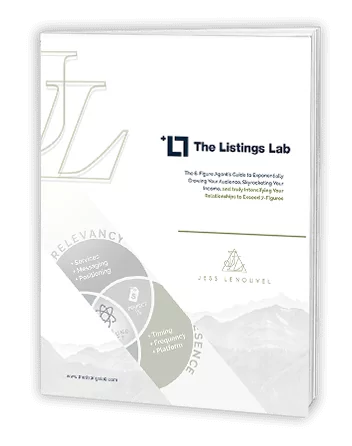Do you have a clearly defined real estate vision and mission?
Or are you just chasing the next deal?
Unfortunately, for many agents today, hustling for their next deal is often their driving focus.
Initially, we got into this business for so many reasons.
- The unlimited income potential
- Flexibility of schedule
- And the chance to make an impact in people’s lives
But the truth is, many of us lose sight of these goals along the way.
If that rings true for you, it’s okay. You’re going to uncover how to get back on track in this blog post.
A lot of the time, agents find themselves unconsciously stuck in a cycle of hustling, until one day, maybe decades into their career, they wake up and ask themselves:
What happened? How did I get here? How did my priorities and my life plan become so unbalanced?
Sure, the rush of closing a deal can feel fun. But eventually, you have to realize that you can’t build a life on the highs and lows of the deal chase.
Your business was created to serve your life, not the other way around.
If you live to serve your business, you’re going to be a slave to it – because you’re operating without intentionality. You don’t really have an idea of where you’re going. You’re running your business day to day, quarter by quarter.
You haven’t taken the time to properly craft your real estate vision and mission.
While entrepreneurs are visionaries, visioning is the number-one thing that many business owners overlook.
The real estate industry as a whole is relatively unpredictable. We’re at the mercy of market changes, seasons, interest rates, and government decisions. As a result, most agents run their business by simply putting one foot in front of the other.
But your real estate vision is also the number-one thing that can move the needle forward in your business. When you have a solid, compelling vision, not only does it help you attract A-players for your team, but it also helps you dominate your marketplace.
There are four core components that go into this important visioning work for your real estate business.
They are as follows:
- Your real estate core values
- Your core purpose (or real estate mission)
- Your brand story
- Your real estate goals, plans, and targets (these are broken down into your ten-year plan, three-year vision, and your quarterly rocks!)
Let’s get into each component so you have everything you need to develop a real estate vision that lays a strong foundation for your seven-figure business.

Real Estate Core Values
Core values are the foundation of building a thriving culture within your business.
Not only do they help guide you as the CEO, but they also serve as signposts for your team members, too.
By telling people in your company what you stand for as a business, they can base their decisions on those values.
This is crucial because it’ll prevent you from having to be available to answer every single question. Core values also determine practices for hiring and firing, reviews, rewards, and recognition.
Real Estate Mission (Your Core Purpose)
Once you’ve got your core values dialed in, your core purpose comes next.
Most coaches will refer to this as your real estate mission.
But I’m talking about something different than the standard generic mission statement you’ll see on nearly every agent’s website.
This is not “we strive for excellence” or “we take the stress out of finding a home”.
I’m inviting you to go deeper.
If you don’t feel 100% clear on your core purpose yet, that’s okay.
Do not feel pressure to nail down your mission right away. It’s normal if it takes you some time to figure it out.
In essence, your core purpose is why you do what you do – and why it matters.
Part of my core purpose for The Listings Lab is to help agents feel less alone.
I remember struggling in isolation as I tried to get my real estate business off the ground.
It wasn’t until I started building my own tribe, when I found people that cared about me and cared about my success, that I was able to truly see what was possible.
It was then that I realized that connecting with others was the core purpose of my business. And when I transitioned into The Listings Lab, my core purpose became helping agents to build relationships at scale.
You have to have a central idea about why you do what you do.
Your Real Estate Brand Story
As you start to bring people into your world, you have to tell a story around your mission.
This is your brand story.
It’s the origin story of who you are, where you came from, and why you’re here today, doing what you do. It should help people to understand your core purpose.
Your brand story should also increase your like, know, and trust factor with your audience.
So many agents only care about being credible and professional with their brand. Of course, those qualities are important, but the vital piece most agents get very wrong—if not completely ignore—is likeability.
When your clients see you as an authority, that means they trust you to provide a service…but they don’t want to buy those services from a robot.
They want to buy them from a person.
Whether or not those clients like you as a person plays a huge part in whether or not they choose you as their agent—and keep choosing you, as well as telling their friends to choose you.
But you can’t communicate your likeability as a bulleted list of benefits.
Let’s face it—any time we see someone list a bunch of great adjectives about themselves, the less likely we are to like that person. So, the best and only way to communicate your true likeability?
Your brand story.
Your Real Estate Goals
While your core values, core purpose, and brand story set the tone for your vision, you need real estate goals to flesh out what that looks like in practice.
We can break these down into longer-term goals (your ten-year target and three-year picture) and shorter-term goals (your one-year plan and your quarterly rocks).
Ten-Year Target
The ten-year target is actually very simple—where do you want your business to be a decade from now?
The ten-year target is your North Star. It’s your “big, hairy, audacious goal,” as Jim Collins put it in his book Built to Last.
To create that target, meet with your core team to discuss where you want to take the business.
First, ask them where they think the organization could be in ten years—it should be something crazy. The whole idea here is to inspire the hell out of everyone on your team to hit that goal. The goal shouldn’t just be revenue-based. Maybe some aspect of social change could come as a result of the revenue earned.
Whatever the goal, it should be something that gets everyone motivated and inspired. It should make everyone believe they have a purpose—and that they know where everyone is going.
Three-Year Picture
Now, it’s time to get a bit more granular with your real estate business goals.
What do you and the team expect the company to look like and to have achieved in three years?
The three-year picture is a terrific recruiting tool. It helps you ask: “Do you want to be a part of a business that looks like this in three years?” If a candidate’s answer is no, you know immediately that they won’t be a good fit.
Why three years?
There is little value in detailed strategic planning more than three years out.
Yes, you still do the ten-year target because you want to know where the ship is heading. But a vivid three-year picture will let your business attract top-quality team members and drive what all agents want, which is market domination.
Your three-year picture should involve a few things:
- Annual revenue over three years
- Profit margins
- And what I like to call your “painting”
Your painting should help you visualize exactly what your business will look like in three years.
The number and quality of the people on your team, the systems and tech you’re using, the clients you’re serving – the whole lot.
You want to get your entire real estate team included in this exercise, if you have one. A 2-hour team meeting should be enough time to get everyone together and on the same page!
When your three-year picture is clear, it improves your one-year planning process because you can easily figure out what you have to do over the next twelve months to stay on track for the three-year picture.
One-Year Plan
The one-year plan brings the long-range vision down to earth and makes it real. It makes your three-year and ten-year goals possible.
Again, the best way to do this is with a two-hour team meeting. I know all of this seems to require a lot of meetings, but they’re worth it because they remove the possibility of people not being on the same page.
Hold the one-year plan meeting at the end of the current year you’re in, even if you’re planning in the middle of the year, just so everyone’s on the same schedule.
In this meeting, determine your yearly revenue picture by asking your team to estimate the annual revenue one year from that day. Once again, the answers will range, but pick a number.
Then, as before, agree on the profit number. Both answers should fall in line with your three-year picture.
Next, set up three to seven priorities or goals to hit your longer-term real estate goals.
Remember, if you make everything important, then nothing is important, so don’t create too many priorities. Those priorities should be what has to be completed this year for you to be on track for your three-year picture.
Quarterly Rocks
Next, set rocks—ninety-day priorities and goals to keep you on track for your one-year plan.
The rock metaphor comes from author Gino Wickman, and it’s one of my favorites.
The idea is you start with an empty jar. Throughout the quarter, the jar gets filled with your day-to-day activities, represented by sand, water, and mud. However, if you don’t put in your priorities—the rocks—first, they won’t fit in the jar and they won’t get done.
At the start of every quarter, put in three to five rocks for your best chance of hitting those goals, which feed into your one-year plan, and so on.
Establishing these priorities lets you maintain focus even when other unexpected situations pop up. You can still execute new ideas and initiatives, but get those three to five things done first, and everything else after that is gravy.
Again, assemble your core team for a one- to two-hour meeting that starts with a brain dump about everything you want to close out in the next ninety days. The list can be anywhere from ten to twenty items. Then make a decision on each one—do you kill it, keep it, or combine it as a quarterly rock?
Narrow it down to no fewer than three rocks and no more than five. Then set the dates when the rocks are due.
Make the quarterly rock objectives super clear, and like other goals, SMART. A good example of a quarterly rock is hiring a new buyer’s agent. A bad example is starting work on the referral process.
Make sure each ‘rock’ has an owner to make sure the project gets completed and that you’re using some sort of project management system to map out the timelines and individual steps necessary for each rock to happen!
Remember, visioning allows you to create the life and business you actually want.
Vision drives your goals.
Goals drive your planning.
Planning drives your resources.
Resources drive your execution.
Execution drives your results.
Your results will become more natural when they come from a place of vision.
So often we build for the sake of building. When you do this, you’ll end up resentful of your business or fall off track, and you won’t even care because your vision wasn’t created from a real place.
So, give yourself that space to work out your real estate vision. The more detailed you can be, the better results you’ll achieve!
If you want support in crafting a real estate business vision that offers you financial AND time freedom – apply to join us in The Listings Lab.
We’ll help you set the foundation for a 7-figure business and teach you step-by-step, the proven strategies and systems you need to dominate your marketplace in just 90 days.












